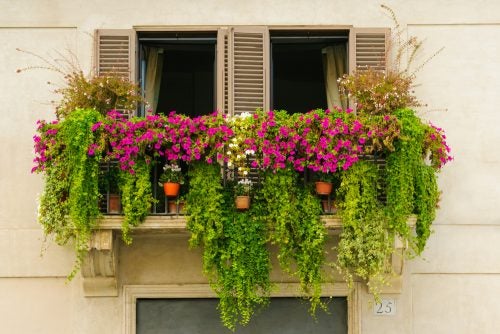Creepers are no longer a symbol of a house’s neglect. Now they are an ornamental element that many people do not hesitate to take advantage of to give a natural touch to their home.

First of all, it should be noted that there are 250 types of creeper. They are perfect plants to decorate and very easy to grow. They belong to the Convol vulaceae family, and it is a very common species throughout the world: Europe, Asia and Africa.
In Europe, Italy is perhaps the country where its cultivation is most common. Especially in gardens, as it is the ideal place for drainage. For this reason, many Italian postcards reveal a beautiful vine.
Would you love a beautiful and magical garden in the purest Italian style? In that case, keep reading because below we will tell you how to grow a vine without damaging your garden.
How is the vine grown and maintained?
There are seeds to be able to grow them “artificially”. Although the most normal thing is that they are born naturally. However, there is no need to worry as it is easy to transplant them.
When the plant is young, it is necessary to water it almost constantly. On the contrary, when it grows up, they are watered more intermittently. The soil must be a soil rich in nutrients and that provides good drainage.
On the other hand, you have to keep your soil dry. Therefore, there are usually no maintenance problems during droughts. What’s more, they prefer warm to humid climates. Indeed, the movies that put creepers in darker castles are lying to us.
Thus, we should not worry about the sun giving them. Of course, there is to keep them safe from the wind and humid and cold climates.
Therefore, we should not worry about the sun. However, the fact that they prefer warm climates does not mean that they do not need water. When there is drought or very hot, they must be watered frequently so that they can survive.
Finally, fertilization is carried out by natural products. These are, for example, worm castings or flowers. They also have to be manured once a year. No more, because even if the manure in abundance produces more green, it produces fewer flowers.
Other care for the vine.
The plants can get sick. In the case of vines, most of the time the problem is fungi and mold. The appearance of these parasites is due, above all, to a high percentage of humidity in the earth. Therefore, they reproduce mostly in the lower part of the vine: ground roots or beginning of the stems. The cause must be treated quickly and effectively, with the right products. Otherwise, the plant could rot in a matter of months.
When the plant has stagnant water or the soil cannot drain properly, that is when it is most vulnerable to getting sick.
- Continuing with the aforementioned fertilizers, it is not good to use them very frequently. And it is that its irregular use will help the vine not to spread to unwanted areas.
On the other hand, transplants should only be done when their size exceeds that of the pot or the inhabited area. A vine that is poorly cared for or larger than its support will make a bad impression on the eye.
Finally, add that the flower of the vine almost always comes out between spring and summer. Therefore, transplants should be done in the fall.
Natural fertilizers.
You don’t have to go to a farm to get natural fertilizers. In other words, manure does not only exist as a natural fertilizer. If we look in the kitchen, we will see a lot of tools for this work. An example of food would be coffee powder, banana peel, or egg shells.
- For example, coffee provides acidity that is beneficial for some flowers such as rose. But if coffee stands out for something, it is due to nitrogen. To use the coffee, you just have to pour it into the ground, pour a large amount of water and let it rest for 2-3 days.
- Bananas, on the other hand, are high in potassium. The potassium is beneficial for the flowers grow further in size. For use, you just have to bury them in the ground and let nature do its job.
- To use the egg shells, you have to crush them well. Once they are powdered, you have to put them on the ground. These peels will provide calcium, which helps prevent rot.
- Other fertilizers can be found in the garden itself: freshly cut grass, weeds or animal food are also useful for plant nutrition. Finally, other more strange fertilizers, but just as effective, are algae and human urine.


